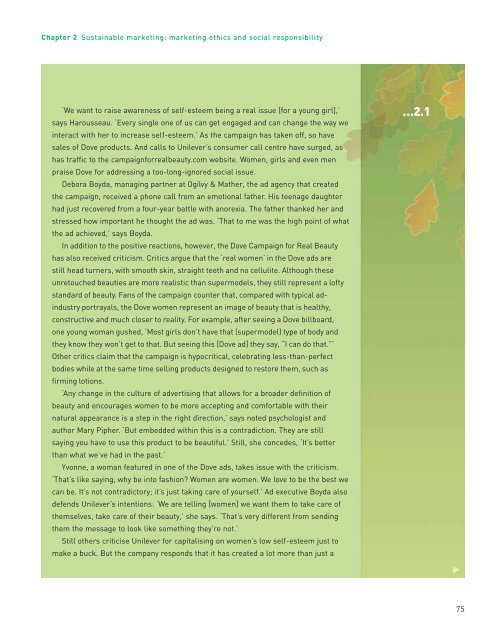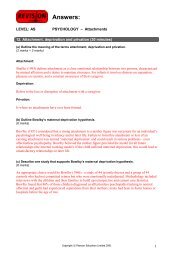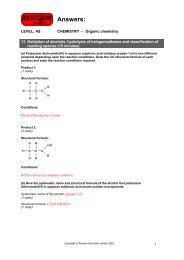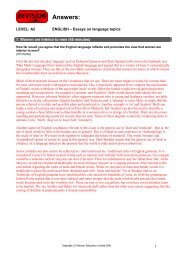Chapter 2 Sustainable marketing: marketing ethics and social responsibility‘We want to raise awareness of self-esteem being a real issue [<strong>for</strong> a young girl],’says Harousseau. ‘Every single one of us can get engaged and can change the way weinteract with her to increase self-esteem.’ As the campaign has taken off, so havesales of <strong>Dove</strong> products. And calls to Unilever’s consumer call centre have surged, ashas traffic to the campaign<strong>for</strong>realbeauty.com website. Women, girls and even menpraise <strong>Dove</strong> <strong>for</strong> addressing a too-long-ignored social issue.Debora Boyda, managing partner at Ogilvy & Mather, the ad agency that createdthe campaign, received a phone call from an emotional father. His teenage daughterhad just recovered from a four-year battle with anorexia. <strong>The</strong> father thanked her andstressed how important he thought the ad was. ‘That to me was the high point of whatthe ad achieved,’ says Boyda.In addition to the positive reactions, however, the <strong>Dove</strong> <strong>Campaign</strong> <strong>for</strong> <strong>Real</strong> <strong>Beauty</strong>has also received criticism. Critics argue that the ‘real women’ in the <strong>Dove</strong> ads arestill head turners, with smooth skin, straight teeth and no cellulite. Although theseunretouched beauties are more realistic than supermodels, they still represent a loftystandard of beauty. Fans of the campaign counter that, compared with typical adindustryportrayals, the <strong>Dove</strong> women represent an image of beauty that is healthy,constructive and much closer to reality. For example, after seeing a <strong>Dove</strong> billboard,one young woman gushed, ‘Most girls don’t have that (supermodel) type of body andthey know they won’t get to that. But seeing this [<strong>Dove</strong> ad] they say, “I can do that.”’Other critics claim that the campaign is hypocritical, celebrating less-than-perfectbodies while at the same time selling products designed to restore them, such asfirming lotions.‘Any change in the culture of advertising that allows <strong>for</strong> a broader definition ofbeauty and encourages women to be more accepting and com<strong>for</strong>table with theirnatural appearance is a step in the right direction,’ says noted psychologist andauthor Mary Pipher. ‘But embedded within this is a contradiction. <strong>The</strong>y are stillsaying you have to use this product to be beautiful.’ Still, she concedes, ‘It’s betterthan what we’ve had in the past.’Yvonne, a woman featured in one of the <strong>Dove</strong> ads, takes issue with the criticism.‘That’s like saying, why be into fashion? Women are women. We love to be the best wecan be. It’s not contradictory; it’s just taking care of yourself.’ Ad executive Boyda alsodefends Unilever’s intentions: ‘We are telling [women] we want them to take care ofthemselves, take care of their beauty,’ she says. ‘That’s very different from sendingthem the message to look like something they’re not.’Still others criticise Unilever <strong>for</strong> capitalising on women’s low self-esteem just tomake a buck. But the company responds that it has created a lot more than just a…2.1▼75
Part 1 Marketing now…2.1series of ads. It is promoting a philosophy, supported by a substantial advertisingbudget, the <strong>Dove</strong> Self-Esteem Fund and a website full of resources designed to buildthe self-esteem of women and young girls.Certainly, Unilever does have financial objectives <strong>for</strong> its <strong>Dove</strong> brand – mostconsumers understand and accept that. If women are not buying the message of<strong>Dove</strong> about the nature of real beauty, then they aren’t buying its products either. Butthe people behind the <strong>Dove</strong> brand and the <strong>Campaign</strong> <strong>for</strong> <strong>Real</strong> <strong>Beauty</strong> have noblemotives beyond sales and profits. According to Fernando Acosta, <strong>Dove</strong> vice-presidentof brand development, the bold and compelling mission of the <strong>Dove</strong> brand to redefinebeauty and reassure women ranks well beyond the issues of money: ‘You should seethe faces of the people working on this brand now,’ he says. ‘<strong>The</strong>re is a real love <strong>for</strong>the brand.’SOURCES: <strong>The</strong>resa Howard, ‘<strong>Dove</strong> ad gets serious <strong>for</strong> super bowl’, USA Today (23 January 2006), accessed atwww.usatoday.com; Don Babwin, ‘<strong>Dove</strong> ads with “real” women get attention’, Associated Press Financial Wire(29 July 2005); <strong>The</strong>resa Howard, ‘Ad campaigns tell women to celebrate how they are’, USA Today (7 August2005), accessed at www.usatoday.com; Pallavi Gogoi, ‘From reality TV to reality ads’, BusinessWeek Online(17 August 2005), accessed at www.businessweek.com; ‘Positioning: Getting comfy in their skin’, Brandweek(19 December 2005), p. 16; Patricia Odell, ‘<strong>Real</strong> girls’, Promo (1 March 2006), p. 24; ‘Beyond stereotypes:Rebuilding the foundation of beauty beliefs’ (February 2006), accessed at www.campaign<strong>for</strong>realbeauty.com;Jeani Read, ‘Women modeling <strong>for</strong> <strong>Dove</strong> love challenging skinny stereotypes’, <strong>The</strong> Calgary Herald (15 May2006), p. C3; and in<strong>for</strong>mation found at www.campaign<strong>for</strong>realbeauty.com, December 2006; Tom Phillips,‘Everyone knew she was ill . . .’, <strong>The</strong> Observer (14 January 2007).In order to persuade customers to buy their brand rather than any other, manufacturerssometimes make claims that are not fully substantiated.<strong>The</strong> recent spate of food scares and the increasing popularity of functional food productsthat claim to have beneficial effects on consumer health have spurred the EuropeanCommission into action. Planned legislation would ban companies from using claims ‘thatmake reference to general, non-specific benefits to overall good health, well-being and normalfunctioning of the body’. So, slogans such as ‘90 per cent fat-free’ and ‘strengthens your body’snatural defences’ would be prohibited. According to the European Commission there is a need toensure that consumers are not fooled by in<strong>for</strong>mation provided on the products. A fundamentalrequirement is that consumers are protected. <strong>The</strong> food industry is less than enthusiastic. <strong>The</strong>ywelcome regulations that would allow companies to use the same labelling across the EU, butfear that the Commission may be overstepping the mark. It may be easy to see why. <strong>The</strong> newregulations would mean that Nestlé LCI yoghurts, Danone Actimel drinkable yoghurt range andUnilever’s Latta margarine would not be able to claim to stimulate, help or strengthen yourbody’s natural defences. Neither would Kellogg’s be allowed to use the little symbols to indicatethe health benefits that it puts on cereals in its range. 1076
















